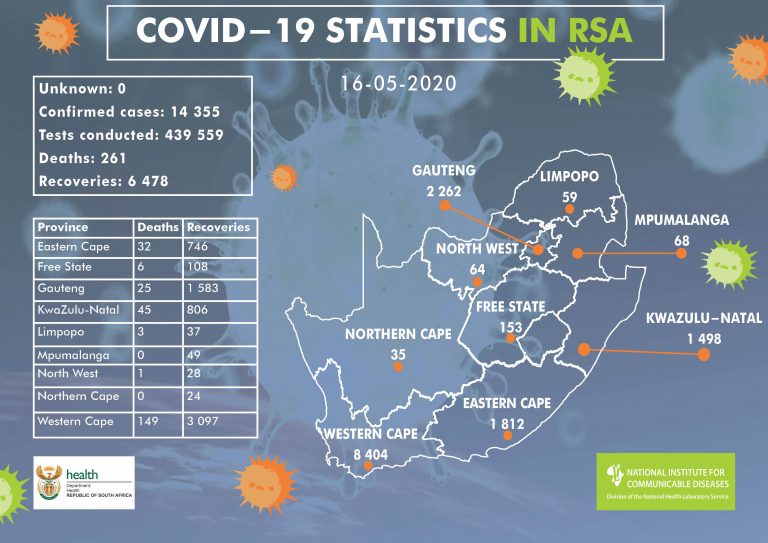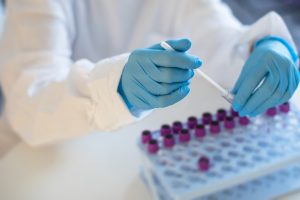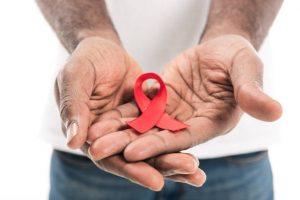As of today, the total number of confirmed COVID-19 cases in South Africa is 14 355 with
831 new cases identified in the last 24-hour cycle of testing.
Case Data
| Province | Total cases for 16 May 2020 | Percentage total |
| Eastern Cape | 1812 | 12,6 |
| Free State | 153 | 1,1 |
| Gauteng | 2262 | 15,8 |
| KwaZulu-Natal | 1498 | 10,4 |
| Limpopo | 59 | 0,4 |
| Mpumalanga | 68 | 0,5 |
| North West | 64 | 0,4 |
| Northern Cape | 35 | 0,2 |
| Western Cape | 8404 | 58,5 |
| Unknown | 0 | 0,0 |
| Total | 14355 | 100,0 |
The Eastern Cape and Western Cape combined comprise 91% of the new 831 cases.
Testing Data
439 559 tests have been conducted with 18 004 done in the last 24-hour cycle.
| Sector | Total Tested | New tested | ||
| Private | 213 172 | 48,5% | 6391 | 35,5% |
| Public | 226 387 | 51,5% | 11613 | 64,5% |
| Grand Total | 439 559 | 18 004 |
Reported Deaths and Recoveries
Regrettably we report a further 14 COVID-19 related deaths- this brings the total national deaths to 261
We wish to express our condolences to the loved ones of the departed and thank the health care workers who cared for the deceased
The total number of recoveries to date is 6478.
| Province | Deaths | Recoveries |
| Eastern Cape | 32 | 746 |
| Free State | 6 | 108 |
| Gauteng | 25 | 1583 |
| KwaZulu Natal | 45 | 806 |
| Limpopo | 3 | 37 |
| Mpumalanga | 0 | 49 |
| North West | 1 | 28 |
| Northern Cape | 0 | 24 |
| Western Cape | 149 | 3097 |
| Total | 261 | 6478 |
WHO RECOMMENDATIONS FOR ASSESSING THE SUITABILITY FOR EASING “LOCK- DOWN” RESTRICTIONS
I am sure many South Africans are eagerly looking forward to a return to normality, albeit a “new normal.”
I would like to take this opportunity to thank each and every one of you for your tenacity, stoicism, and true partnership with the government. Together we succeeded in flattening the curve, which facilitated ramping up and cohesion of our health care system as well as preparation of our spaces as we resume our economic and social development.
A few examples are that we have screened 10 737 341 citizens, we now have 376 sites identified for quarantine nationally with 30 823 quarantine beds. Significantly our mortality rate, 1.8%, remains well below the global average which is currently 6.6% and our recovery rate is 42.4%, above the global average of 38%.
The process of easing lockdown regulations is a highly consultative one where various stakeholder inputs are taken into account to influence implementation.
We remain guided by the World Health Organization recommendations for easing lockdown restrictions, which are:
- Strong surveillance, cases are declining and transmission is controlled
- Health systems capacity is in place to detect, isolate, test and treat every case and trace very contact
- That outbreak risks are minimized especially in settings like facilities and nursing homes
- That preventive measures are in place in workplaces, schools and other places that are essential for people to go
- That importation of cases can be managed
- That communities are fully educated, engaged and empowered to adjust to the new norm
The Director-General of WHO Dr. Tedros Ghebreyesus continued by saying: “The risk of returning to lockdown remains very real if countries do not manage the transition extremely carefully and in a phased approach.”





